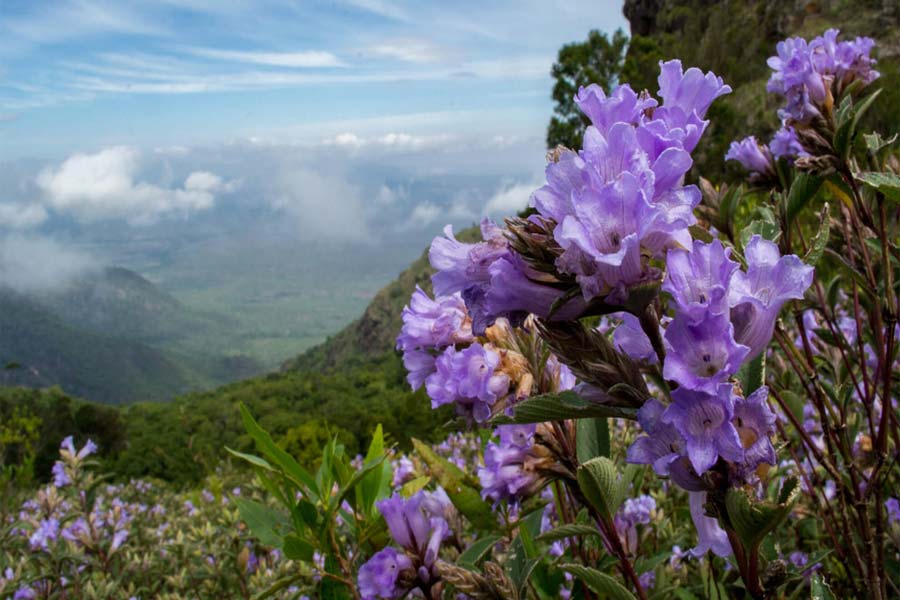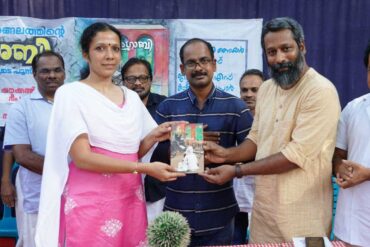
Early in April, as Kerala geared itself up for the 17th Lok Sabha elections, a massive fire broke out in the Anamudi Shola National Park in the high ranges, causing extensive damage to some 50 acres of forest lands in Idukki district.
For three days, the fire ravaged through the regions earmarked for a Kurinji park, named after the wild flora species that bloom once in 12 years. It was reported in the local media that this fire could probably have been an act of sabotage by land-grabbers operating in the region. In the din and frenzy of the election campaign, the matter got buried.
It was in October 2006, during the previous blooming season, the government of Kerala announced its decision to establish a sanctuary for Neelakurinji, the purple-blue flower that blooms in the Nilgiri shola grasslands once in 12 years.
This rare flora, Strobilanthes kunthiana, once widespread in the Nilgiri’s vast grasslands, is an endangered flora, restricted mainly to a few villages atop the Munnar hills in Kerala’s Idukki district and scattered in some parts of Kodaikkanal in Tamil Nadu.
Its blooming season attracts a huge flow of tourists—the number of visitors nearly touching a million during the August-October months in 2006 in Munnar, bringing its own problems to this ecologically fragile region. The recent blooming season in 2018 attracted fewer visitors on account of the deluge.
The proposal for a sanctuary comprising some 32 sq. km of land in the hills was announced by the then Forest and Environment Minister, Binoy Viswam through a gazette notification issued under the Wildlife (Protection) Act 1972.
The sanctuary was proposed in an area contiguous to other national parks in the Western Ghats, including the Chinnar wildlife sanctuary to the Northwest, the Indira Gandhi Wildlife Sanctuary to the Northeast, the Eravikulam and Anamudi Shola National Parks to the West, the Pampadum Shola National Park to the South and the Palani Hills National Park to the East. This entire region falls within the Nilgiri Biosphere Reserve, among the hotspots for bio-diversity in Asia.
Strobilanthes Kunthiana got its name from the river Kunthi that flows from the hills of the Silent Valley. Silent Valley had earned the status of a national park after a long-drawn public agitation in the 1970s, when environmental activists opposed the move to build a dam on the river for hydroelectric power generation. Ever since, there have been several studies on the ecological fragility of the region and the need for safeguarding ecological balance of the Western Ghats.
Faced with the challenge to protect the fragile ecology in the face of encroachments into the forest lands, administrators and policy makers realized that establishing national parks with no human settlements was the only solution. In the Western Ghats stretching across five states, there are several national parks that helped protect the flora and fauna that would otherwise have faced severe threats to their survival.
Still, large patches remained susceptible to encroachment and fresh settlements. The vast grasslands in Munnar have seen a massive influx of people in recent times, determined to make a living in those highlands. The 2006 decision to safeguard the Kurinji flowering hills into a Sanctuary was taken in view of the increasing threats to the flora and fauna in the Nilgiri Biosphere.
The original gazette notification, issued on 6 October 2006, proposed that the new park would comprise areas mainly in the two revenue divisional villages of Kottakamboor and Vattavada in Devikulam taluk.
The Kurinjimala Sanctuary, as it was officially named, was welcomed as a forward-looking move to protect the environment and wildlife in this area, home to rare and endangered flora and fauna including the Nilgiri Tahr. Among the animals and birds seen here are Asian elephants, Gaur, the Grizzled giant squirrel, Nilgiri wood pigeon, Crested serpent eagle, Crested goshawk, spot-bellied eagle Owl, Alpine swift, Grey junglefowl, Nilgiri flycatcher etc.
The setting up of a new sanctuary in an area contiguous to other wildlife parks was expected to protect the foraging space for wildlife. The long-festering issue of man-animal conflict in the area was also expected to be contained this way.
Sadly, it was not to be.
13 years have passed with another Kurinji season in between and the great flood that followed but the Kerala government has not put out a final notification for the sanctuary.
A final notification earmarking its boundaries would have protected the site from encroachers. It is well-known that during the impending period, a large part of the Kurinji-blooming lands that fall in the proposed sanctuary has been encroached upon by private entities. Among them are very powerful politicians—including a Member of Parliament from Kerala.
The Kerala government had made several attempts to notify the Kurinji sanctuary, but efforts to complete land survey and earmark the boundaries failed owing to stiff resistance from local people and politicians.
There are allegations that many local politicians have vested interests. A tract of land owned by the local Member of Parliament, whose claims of his father purchasing it from local people decades ago, is now caught in a dispute as the veracity of the title deeds is being scrutinized by the court. And hence, authorities have been unable to complete the survey and fix boundaries, enabling further encroachment.
Land-grabbing is a phenomenon widespread in the entire Western Ghats. But in Munnar, it has reached epidemic proportions. Huge tracts of public property and poramboke land are encircled and occupied by settlers with political patronage to build resorts and cater to tourists. The official machinery has often been accused of being in cahoots with them.
Those officials who dared to act against illegal activities in these remote regions have a different tale to tell. They often get into trouble with the political establishment, and are pulled up for performing their duty. Sriram Venkataraman, the former Devicolam Sub-Collector, who acted promptly to evict land-grabbers, was severely castigated by the Chief Minister himself –accusing the young official of hurting religious sentiments.
The classic confrontation between the land-grabbers and officialdom took place during 2006-2011, when the VS Achuthanandan-led LDF government undertook a concerted effort to evict land-grabbers in Munnar. Ultimately, the government had to beat a retreat.
The nexus between political party leaders and the land sharks and builder lobby has been ongoing in the Munnar region since 1995, when a proposal was mooted to revive an abandoned road that links Munnar with Kodaikkanal in Tamil Nadu through forestland.
This road was originally developed by the British military administration during the Second World War for emergency evacuation, at the peak of Japanese threats to the colonial Indian administration in 1942. This road continued to be operational for a few decades after Independence and was closed down following disputes over control between the Tamil Nadu and Kerala state governments.
The commercial possibilities arising out of a direct road from Kodaikanal to Munnar were immense and soon, land grabbing operations in Munnar became commonplace. Prior to this, the earlier settlers in the region were poor peasants from Tamil Nadu.
In the early 2000s, hundreds of acres of lands were bought by companies from settlers who had temporary titles to the lands they occupied. The Supreme Court had ordered conferring of titles to landless peasants who had settled in the hills before January 1977. But the local political leaders now demand that all those who sit on the lands be given titles irrespective of the time of settlement.
This has complicated the situation with regard to Kurinjimala Sanctuary, as the government finds it difficult to free up the part of the proposed sanctuary area now occupied by settlers or taken over by land-grabbers.
The problem is acute in the two revenue blocks of 58 and 62, situated in the Kottakamboor and Vattavada villages in Devikulam taluk respectively. As the revenue department officials made repeated attempts to measure and earmark the boundaries of the sanctuary, the settlers and local politicians stopped them, often resorting to violence. In order to find a solution to the vexed issue, a team of officials from the government, led by the Minister for Forests and Environment, K Raju, undertook an inspection tour of the sanctuary site a year ago.
The situation was complicated, as there were small settlements within the earmarked sanctuary area in places like Vattavada. In fact, ward three of the Vattavada panchayat, Kadavari, lies entirely within the proposed site. There are hundreds of homesteads and some shops and other establishments in this part of the sanctuary. These people, mostly made up of Scheduled Castes who originally migrated from Tamil Nadu, are unwilling to abandon their plots and move elsewhere.
Hence, the final declaration of the sanctuary is in limbo. It remains to be seen if the Kurinjimala Sanctuary would actually comprise the 32 sq.km proposed originally. The minister sounded vague when he stated that the original proposal was based on estimation, with the actual extent to be fixed after a survey. He said the contours of the sanctuary might have to be redrawn with some hamlets like Kadavari remaining within it as special enclosures, in case the settlers refuse to move out.
This will ultimately foil the sanctuary project as the villagers allowed to remain in the precincts gradually expand. The recent fires are a warning that if settlers remain there, it would mean the extinction of this rare species of flora in a few years. The Kerala Government has a difficult task at hand: How to pull off the ecologically significant project without hurting the settler peasants.
It is to be seen whether the government and the civil society can find a solution, persuading these people to move elsewhere, so that future generations continue to witness Kurinjis make their purpled-visitations once in 12 years.






